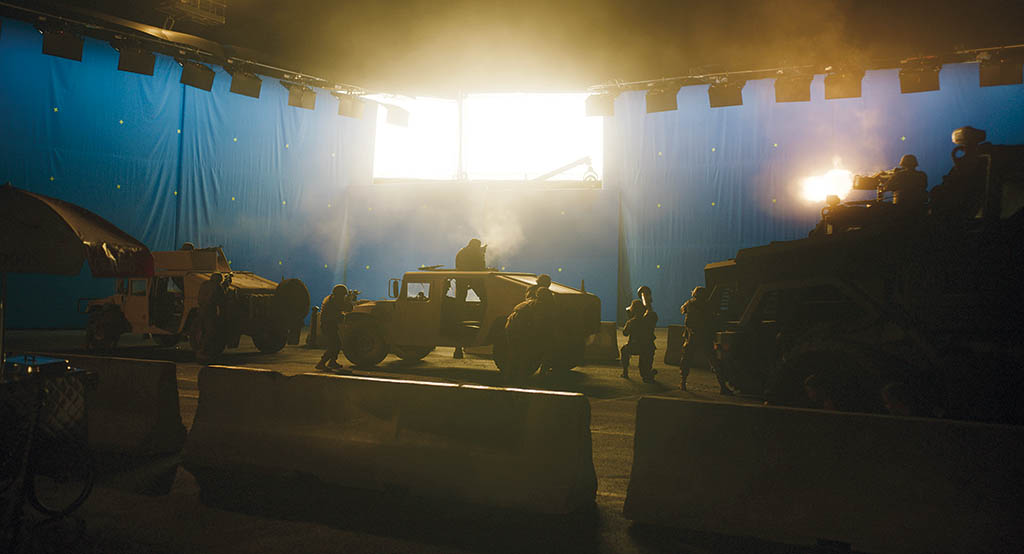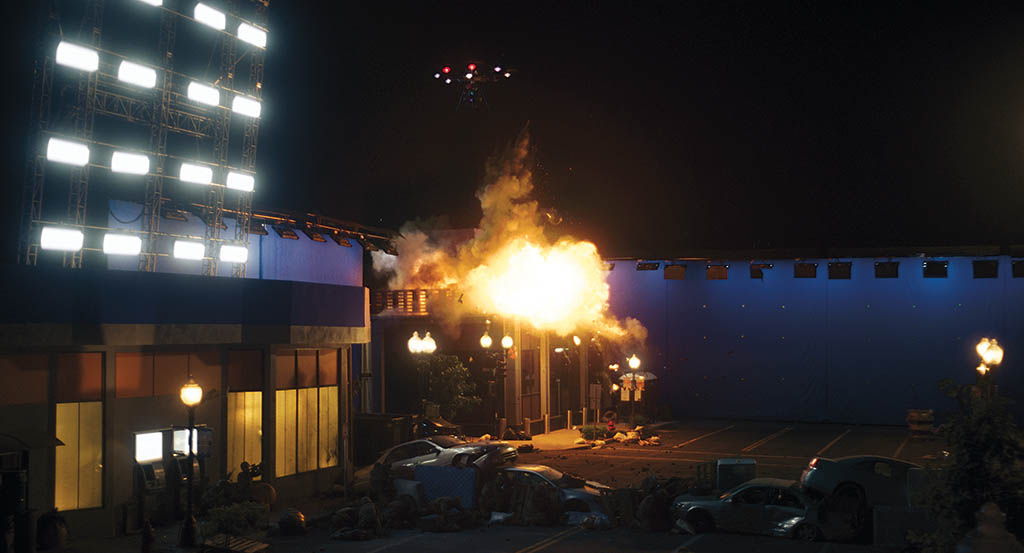By CHRIS McGOWAN
By CHRIS McGOWAN
Images courtesy of A24.

Kirsten Dunst is a war-zone photojournalist trying to reach D.C. in Civil War. (Photo: Murray Close)
In the near future, a fractured America is at war with itself. The President has called citizens to arms against the breakaway Florida Alliance and the Western Forces of California and Texas, which are attempting secession from the U.S.A. Alex Garland, who wrote 28 Days Later and wrote and directed Ex Machina, Annihilation, Men and the FX series Devs, scripted and directed the A24 film. Kirsten Dunst stars as a photojournalist and war-zone veteran who is traveling across a dystopian, perilous landscape as the Second American Civil War escalates. The cast includes Wagner Moura (Narcos), Jesse Plemons (Killers of the Flower Moon), Stephen McKinley Henderson (Dune), Cailee Spaeny (Priscilla), Sonoya Mizuno (Devs) and Nick Offerman (The Last of Us). The film is “set at an indeterminate point in the future” and “serves as a sci-fi allegory for our currently polarized predicament,” Garland said in an interview with The Daily Telegraph.
Framestore was the main VFX creative studio, with a small in-house comp team provided by TPO, according to VFX Supervisor David Simpson. Some 1,000 VFX shots, split between Framestore and TPO, bring the shocking urban warfare to life, including the obliteration of the Lincoln Memorial. “Our VFX team was pretty small, but I love working that way,” Simpson comments. “With a small team, the collaboration is the best part. Everyone’s in the loop, sharing ideas, helping to make the film the best it can be.”
Civil War is a road movie, which required a certain approach. Simpson says, “When it came to world-building it needed to feel grounded – almost like a documentary – so real locations played a huge part in the film. Plus, the world needed to feel populated. It was important that the audience believed people still lived here, which meant a lot of cast members and supporting artists. Almost every scene takes place in a new location with new people, which meant we were constantly on the move.”

Framestore was the main VFX creative studio, with a small in-house compositing team provided by TPO. Approximately 1,000 VFX shots were split between Framestore and TPO to bring the shocking warfare to life.
The number one VFX challenge was creating a replica of Washington D.C. Simpson explains, “Plan A was to find locations in Atlanta that could play for Washington D.C., but it quickly became apparent that wasn’t going to work – aesthetically or logistically. So, the production pivoted to building a number of sets and extending them in VFX. We built three sets in a parking lot in Atlanta. We called them Pennsylvania Avenue, the Lincoln Memorial and 17th Street. On-Set Supervisor Chris Zeh and I marked out the roads with tape to 80% scale, as the space wasn’t large enough to fit 1:1. Each set was a single story tall and maybe one or two buildings deep. Then, our VFX Producer Michelle Rose and Lead Wrangler Corey Burkes flew to D.C. to capture the real locations for Framestore to recreate them digitally.”
Simpson adds, “As we saw the city come together, it looked so good we decided to use it for a handful of big establishing aerial shots. Whenever we’re in a helicopter over Washington D.C – that’s always full CG. The detail is wild. The environments team under the supervision of Freddy Salazar, our CG Supervisor, didn’t just build a city, they built a full war zone. There are individual skirmishes happening with gunfire and explosions. We have tanks, Humvees and police cars driving around.
“Every CG building has a CG interior – offices with individual desks, chairs, whiteboards, potted plants. There’s even CG clutter on CG desks,” Simpson. “That CG clutter sometimes contained an inside joke. “On some desks, you might even spot little rubber ducks. This is a nod to the Framestore team because many years ago, on a previous project, the team received rubber ducks as a wrap gift. They’ve peppered our offices ever since! It’s a very specific tip of the hat to Framestore’s inner working life.”

Seamlessly blending the real and invisible VFX sometimes created moments where it was hard to tell whether the shot was real or not, adding drama to the storytelling.

Photojournalist Kirsten Dunst risks her life navigating a dangerous dystopian landscape as the Second American Civil War erupts. (Photo: Murray Close)
Down below in the simulated city, “There are shops with displays inside, some streets are barricaded off, and even the traffic lights work! You could put the camera anywhere and it looked fantastic,” Simpson remarks. Chris Zeh adds, “Building the entirety of Washington for a flyover and individual streets as higher-resolution backdrops, hero explosions and digital people, shelled office blocks, tanks and planes and helicopters and a lot of shots fired – all of these had their sets of challenges.”
Zeh continues, “Specifically for comp, a lot of our set extensions needed integrating in footage with trees and people, flaring lenses at night and often quite dynamic camera moves. Most of the plates were shot on location with all the natural variability of the outdoors. All of this needed recreating and bedding in, and sometimes even seemingly similar shots needed quite different approaches. It is worth mentioning the paintwork, too. Some shots needed removal of buildings or pedestrians or traffic to arrive at the eerie emptiness you would find in places in the midst of a civil war.” Zeh notes, “From a personal perspective, I might also add that we went through a lot of reference material to get the look right. And due to the nature of the images, I would say that counted as challenging.”

Civil War is a road movie with a grounded, almost documentary approach. Real locations played a big part in the film.

Beyond the core group of journalists and soldiers, a wider war was being fought involving many other people and their stories. Almost every scene takes place in a new location with new people, which kept the crew on the move.

One sign of activity in a war zone was a crashed helicopter shot down by ground fire.
No LED stages were used. “Everything was shot in the real world with occasional set extensions,” Simpson says. There were also lots of digital crowds, such as in the scene in Brooklyn at the beginning. He adds, “We had a lot of performers on set, but filled gaps with a combination of digital and greenscreen crowds to make it look even more crowded. The helicopter shot in that sequence was actually filmed about nine months later from a drone, so that crowd’s 100% digital.”
“For the Washington D.C. sequence – that’s maybe 30% digital soldiers,” Simpson explains. “Everyone in the foreground is a stunt performer, then the further away we get the more we introduce digis. Again, this was to make the world feel populated. As an audience, we were up close with the journalists and a small group of soldiers, but beyond was an entire war with countless other people and stories. Our animation team, supervised by Max Solomon, used a combination of mocap and hand animation to try and create that sense of wider activity.”
Regarding blowing up the Lincoln Memorial, Simpson jokes, “Look, we tried to do as much for real as possible, but even that has its limits! Shockingly, it’s not the real Lincoln Memorial.” Instead, he notes, “We went to Washington D.C. and scouted all the locations to get a feel for how it was lit, the scale, etc., but the scene itself was shot in a parking lot in Atlanta. The foreground performers, the vehicles and the trees behind them are all real, but they’re firing at a bluescreen with a giant hole in the middle. Inside the giant hole was an enormous glowing rectangle that represented the Lincoln Memorial. This gave us realistic lighting with the added benefit of helping the soldiers know where to shoot.
“The explosion itself,” Simpson continues, “is pure FX. Authenticity and realism were really important on this project. We wanted to avoid anything that felt ‘Hollywood.’ so we spent weeks ‘casting’ our explosions. We put together a library of news footage, ammunition tests, anything real we could find. Then Alex chose a hero clip for each scene and that served as a reference to keep things honest. Our FX team, led by Effects Supervisor Ed Ferrysienanda, diligently recreated the nuances and details seen in real footage. Every explosion is based on something real.”
Perhaps the most unusual challenge for Simpson was working on the VFX for Civil War while still delivering the visual effects for Alex Garland’s previous movie, Men. “Based in Atlanta, we’d spend the day prepping for Civil War, then in the evening we’d meet up to review Men, where the team was based in London. We graded the last shot on Men about 24 hours before shooting started on Civil War.”
Zeh felt a sense of accomplishment when the real and unreal blended together seamlessly in Civil War. “While working on a project, I find the increments are often quite small. Although you see the shots take shape and improve steadily, there is rarely a moment of ‘Eureka!’ while we’re still working on them. But there are moments where I needed to remind myself whether a certain part of a shot was real or not. I really enjoy the type of work that mostly falls into the category of ‘invisible VFX,’ and those moments are fantastic. Then seeing the trailer which features a lot of our work, and how it plays in context with other shots was great. Can’t wait to see it on the big screen. That’s usually the moment for me.”
Says Simpson, “On this show, I’m proud of the work as a whole. It feels like one complete body of work. I haven’t seen it in IMAX yet. There’s a lot of scale to the movie and some absolutely epic shots. I can’t wait to see them on a massive screen.”


Blowing up the Lincoln Memorial was shot in a parking lot in Atlanta. The single-story-tall set was extended in VFX.


Every explosion was based on something real, such as news footage and ammunition tests. The VFX team recreated the nuances and details seen in the real footage.